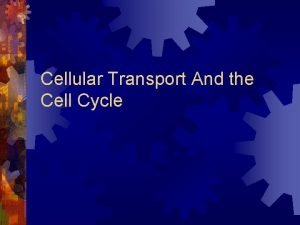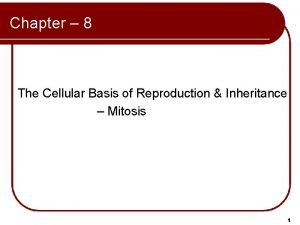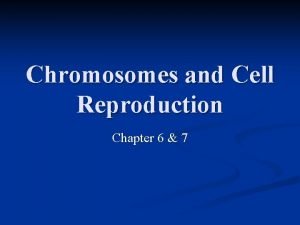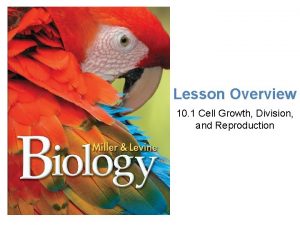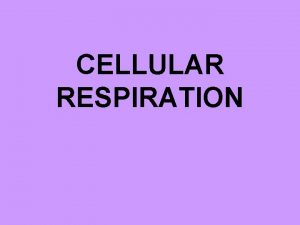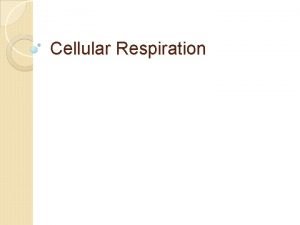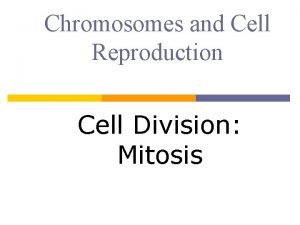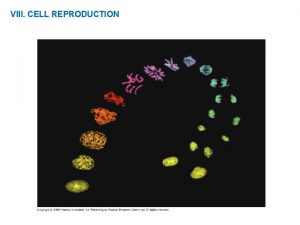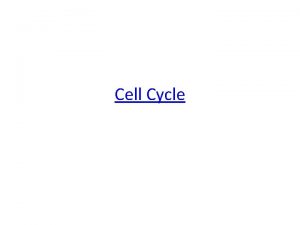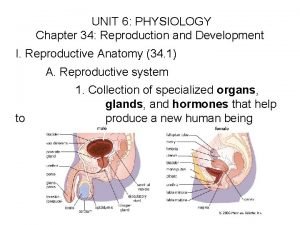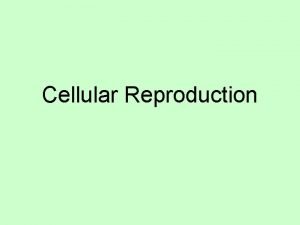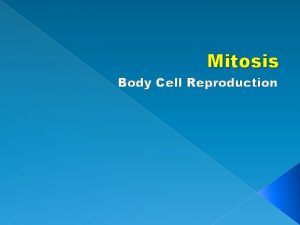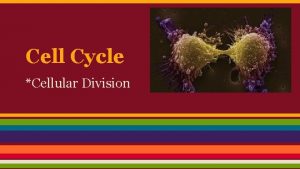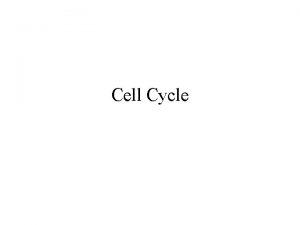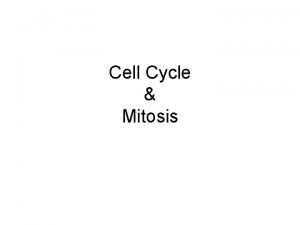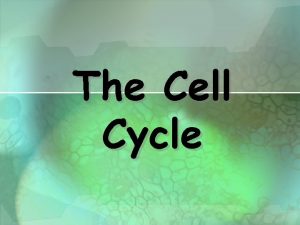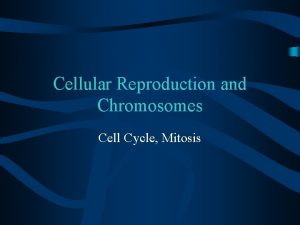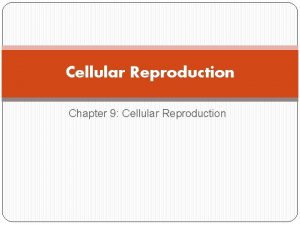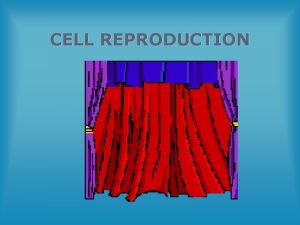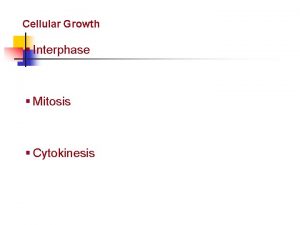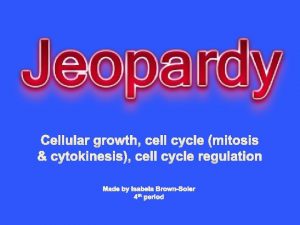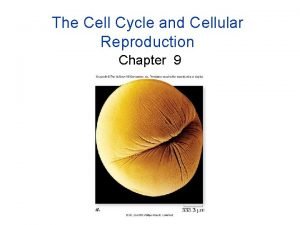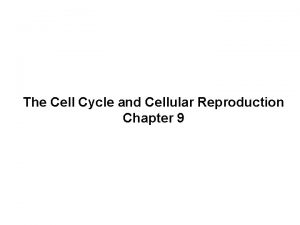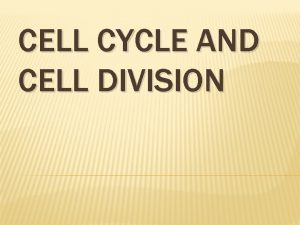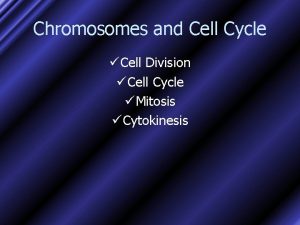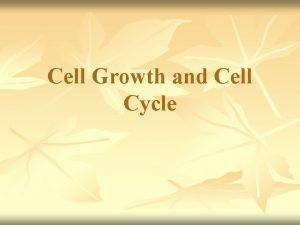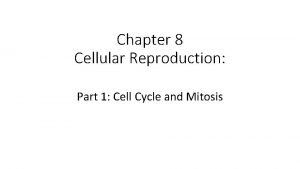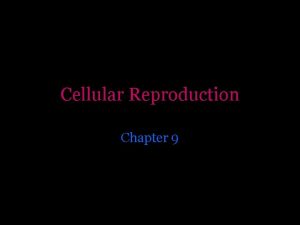Chapter 9 Cell Cycle and Cellular Reproduction AP










































- Slides: 42

Chapter 9: Cell Cycle and Cellular Reproduction AP Biology Mr. Freidhoff

9. 1 Chromosomes • Chromosome: Tightly packed DNA and protein structure. • Histone: Protein molecule that DNA wraps itself around. • Chromatin: Thin thread of DNA. Condenses before mitosis. Consists of DNA and packaging proteins.


9. 1 Chromosomes • Chromatid: Arm of Chromosome, made of DNA double helix. • After replication, chromosome doubles the amount of DNA. • Sister Chromatids: Identical DNA strands that remain attached until mitosis.

9. 1 Chromosomes • Centromere: Sister chromatids are attached at region with many DNA repeats. • Kinetochores: Regions on the centromere where spindle fibers will attach.

9. 1 Chromosomes • Diploid (2 n): Number of average chromosomes in a somatic cell. Includes two chromosomes of each kind. • Haploid (n): Cells that contain only one of each chromosomes. • Sperm and Egg. • Homologous Chromosome: Pair of chromosomes with the identical genes in the same order.

9. 2 The Cell Cycle • Cell Cycle: Set of stages that take place when a cell divides.

9. 2 The Cell Cycle • Interphase • Most of the cell cycle is spent in interphase. • Cell performs normal functions. • Three parts of Interphase: G 1, S, G 2

9. 2 The Cell Cycle • G 1 (Growth or Gap phase) • Recovers from previous division. • Grows in size. • Increase the number of organelles. • Accumulates materials for DNA synthesis. • Chromosome is NOT condensed.

9. 2 The Cell Cycle • S Phase • Synthesis or Replication Phase • Before S phase, DNA chromosomes are composed of one double helix. • After S phase, the DNA is composed of strands of identical DNA. • Chromosome is NOT condensed.

9. 2 The Cell Cycle • G 2 Phase: • Cell synthesizes proteins that assist in cell division. • Ex: Microtubules • Centriole replication complete. • Chromosome is NOT condensed.

9. 2 The Cell Cycle • Go Phase: “Lazy Phase” • Cell continues normal functions, doesn’t divide. • Nerve cells, muscle cells, etc. • Control of cell division.

9. 2 The Cell Cycle • M phase • Mitosis: Nuclear Division • Cytokinesis: Division of Cytoplasm • Chromosome is condensed.


9. 3 Mitosis • Centrosome: Main microtubuleorganizing center of the cell. • Only have one centrosome until S phase. • Centrioles: Barrel shaped organelles found in pairs at right angles. • Located next to Nucleus. • Organizes mitotic spindle which are fibers of microtubules. • Anchor cytoskeleton into membrane.

9. 3 Mitosis • Prophase: • Chromatin have condensed. • Chromosomes composed of duplicated chromatid. No orientation. • Nuclear membrane starts to break down. • Aster: Microtubules that come out of centrioles. Make star like pattern.

9. 3 Mitosis • Prometaphase: • Kinetochores on each side of centromere appear. • Spindle fibers attach to kinetochores. • Chromosomes still aren’t oriented.

9. 3 Mitosis • Metaphase: • Centromeres of Chromosomes are aligned along middle of the cell called the metaphase plate. • M-Phase Checkpoint • Cell checks to make sure spindle fibers is attached to each kinetochore.


9. 3 Mitosis • Anaphase: • Sister chromatids separate. • Spindle fibers shorten pulling chromatids to poles of the cell. • Shortest phase.


9. 3 Mitosis and Cytokinesis • Telophase: • Spindle fibers dissemble. • Nuclear envelope starts to form around chromosomes. • Chromosomes start to unwind.


9. 3 Mitosis • Cytokinesis: • Division of cytoplasm. • When Cytokinesis doesn’t occur, results in multinucleated cell.

9. 3 Mitosis • Animal: Cleavage furrow forms from microfilament ring constricting. • Plant: Vesicles that contain cell wall components help form cell plate which creates new membrane.

9. 4 Cell Cycle Regulation • Growth Factors: Signals received by proteins in the plasma membrane to divide.

9. 4 Cell Cycle Regulation • Cyclins: Internal signaling proteins that increase or decrease the amount of cellular division that occurs. • Cdk, Cyclin Dependent Kinases: Enzymes, always present, need activated by cyclin proteins.



9. 4 Cell Cycle Regulation • G 1 Checkpoint • Checks to make sure the cell has enough room and organelles to replicate.

9. 4 Cell Cycle Regulation • Apoptosis: Programmed cell death. • Caspases are enzymes, usually inhibited, that break down internal and external structures. • Cell loses contact with neighboring cells, nucleus fragments, membrane develops blisters and get broken down.

9. 4 Cell Cycle Regulation • G 2 Checkpoint • Checks if DNA replication has finished. • Also checks DNA for Damage.

9. 4 Cell Cycle Regulation • Mitotic Phase Checkpoint • Cell checks if chromosomes have attached correctly to mitotic spindle.

9. 4 Cell Cycle Regulation • p 53: Stops cell division if DNA is damaged. • p 53 tries to initiate DNA repair at first. Can also stop cell cycle, called cell growth arrest. • If large amounts of mutations occur, p 53 will initiate apoptosis.


9. 5 Cancer • Cancer: Uncontrolled cell growth. • Caused by mutations on genes that control cell division. • Great variation within types of cancer. • Benign Growth: Tumor that lacks ability to migrate. • Malignant Growth: Cancerous cells spreading.

9. 5 Cancer • Cancer cells lack differentiation. • Don’t contribute to the overall function of tissue. • Cancer cells have abnormal number of nuclei. • Abnormal amount of chromosomes.

9. 5 Cancer • Cancer cells do not undergo apoptosis. • Controlled cell death doesn’t occur. • Cancer cells form tumors. • Cancer cells pile on top of each other.


9. 5 Cancer • Cancer cells undergo metastasis and angiogenesis. • Metastasis: Cancer cells move around the body causing the cancer to spread. • Angiogenesis: formation of blood vessels into tumor. Allows cancer to spread.

9. 5 Cancer • Mutations on genes that signal cell division cause problems. • Proto-oncogenes: Genes that codes for proteins that promote the cell cycle and prevent apoptosis. Become oncogenes. • Analogy: Gas pedal of a car. • Tumor Suppressor Genes: genes that code for proteins that inhibit the cell cycle and promote apoptosis. • Analogy: Brakes of a car.

9. 5 Cancer • Telomeres: Ends of chromosomes that protect the inner most part of a chromosome. • Repeated DNA that does not code for any genes. • As a cell divides, ends of the telomere get cut off. • If a telomere gets cut down to nothing, it stops dividing. • Mutations in genes that code for enzymes that elongate telomeres might cause cancer.
 Cellular transport and the cell cycle
Cellular transport and the cell cycle Chapter 9 section 1 cellular growth
Chapter 9 section 1 cellular growth Chapter 9 section 1 cellular growth
Chapter 9 section 1 cellular growth Chapter 9 cellular reproduction
Chapter 9 cellular reproduction Chapter 8 cellular reproduction cells from cells
Chapter 8 cellular reproduction cells from cells The cellular basis of reproduction and inheritance
The cellular basis of reproduction and inheritance Asexualk
Asexualk Chapter 6 chromosomes and cell reproduction
Chapter 6 chromosomes and cell reproduction Asexual reproduction cell division
Asexual reproduction cell division Asexual vs sexual reproduction venn diagram
Asexual vs sexual reproduction venn diagram Events of the cell cycle
Events of the cell cycle Cell cycle and cell division
Cell cycle and cell division Cell division phases
Cell division phases Biology.arizona.edu/cell bio/activities/cell cycle/01.html
Biology.arizona.edu/cell bio/activities/cell cycle/01.html Cell growth division and reproduction
Cell growth division and reproduction The scientist mathias schleiden studied _______ in ______.
The scientist mathias schleiden studied _______ in ______. What type of cell performs cellular respiration
What type of cell performs cellular respiration Where in the cell does cellular respiration occur
Where in the cell does cellular respiration occur Cellular respiration formula
Cellular respiration formula Cell reproduction
Cell reproduction Asexual reproduction cell division
Asexual reproduction cell division Cell of reproduction
Cell of reproduction Cell reproduction
Cell reproduction Chapter 5 principles of engine operation
Chapter 5 principles of engine operation Chapter 10 sexual reproduction and genetics
Chapter 10 sexual reproduction and genetics Chapter 20 reproduction and pregnancy
Chapter 20 reproduction and pregnancy Chapter 10 sexual reproduction and genetics
Chapter 10 sexual reproduction and genetics Chapter 34 reproduction and development answer key
Chapter 34 reproduction and development answer key Advantages of diaphragm cell
Advantages of diaphragm cell Prokaryotic reproduction
Prokaryotic reproduction Difference of animal cell and plant cell
Difference of animal cell and plant cell Tonoplast
Tonoplast Rough endoplasmic reticulum function
Rough endoplasmic reticulum function Primary battery and secondary battery
Primary battery and secondary battery Difference between plant cell and bacterial cell
Difference between plant cell and bacterial cell Life
Life Idealized animal cell
Idealized animal cell Walker cell and hadley cell
Walker cell and hadley cell Plant cell and animal cell venn diagram
Plant cell and animal cell venn diagram Galvanic vs electrolytic cell
Galvanic vs electrolytic cell Animal cell and plant cell
Animal cell and plant cell Chapter 8 section 3 cellular respiration
Chapter 8 section 3 cellular respiration Chapter 8 lesson 1 life is cellular
Chapter 8 lesson 1 life is cellular
